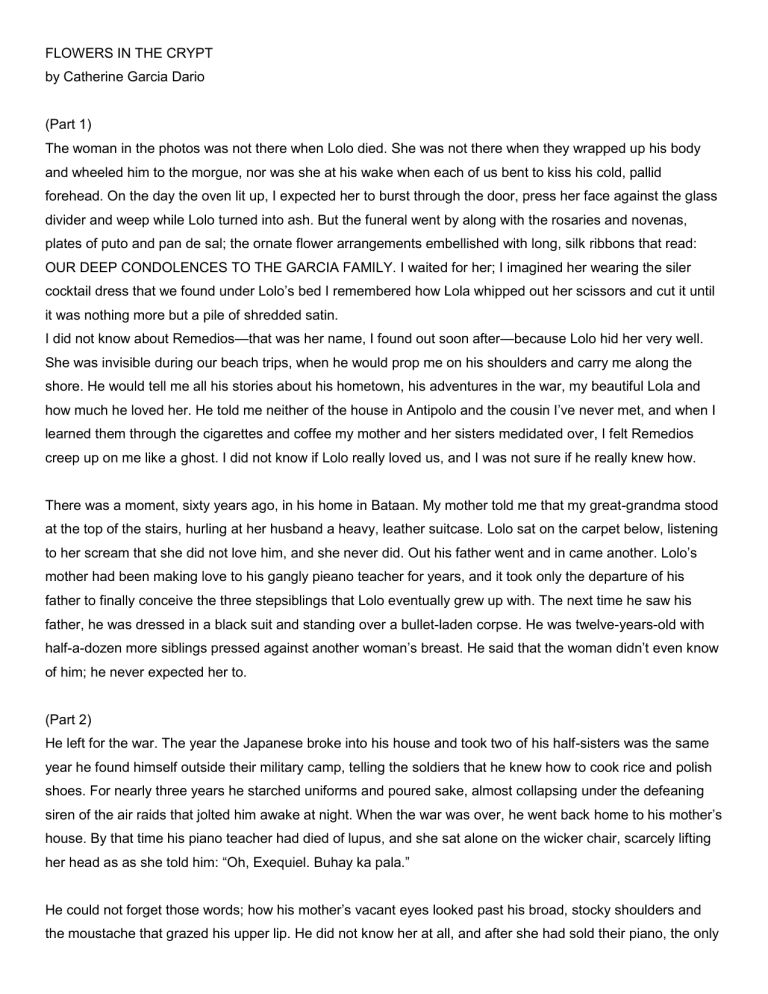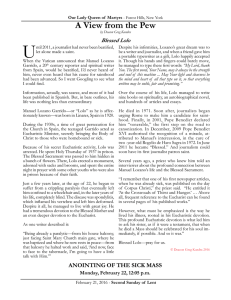
FLOWERS IN THE CRYPT by Catherine Garcia Dario (Part 1) The woman in the photos was not there when Lolo died. She was not there when they wrapped up his body and wheeled him to the morgue, nor was she at his wake when each of us bent to kiss his cold, pallid forehead. On the day the oven lit up, I expected her to burst through the door, press her face against the glass divider and weep while Lolo turned into ash. But the funeral went by along with the rosaries and novenas, plates of puto and pan de sal; the ornate flower arrangements embellished with long, silk ribbons that read: OUR DEEP CONDOLENCES TO THE GARCIA FAMILY. I waited for her; I imagined her wearing the siler cocktail dress that we found under Lolo’s bed I remembered how Lola whipped out her scissors and cut it until it was nothing more but a pile of shredded satin. I did not know about Remedios—that was her name, I found out soon after—because Lolo hid her very well. She was invisible during our beach trips, when he would prop me on his shoulders and carry me along the shore. He would tell me all his stories about his hometown, his adventures in the war, my beautiful Lola and how much he loved her. He told me neither of the house in Antipolo and the cousin I’ve never met, and when I learned them through the cigarettes and coffee my mother and her sisters medidated over, I felt Remedios creep up on me like a ghost. I did not know if Lolo really loved us, and I was not sure if he really knew how. There was a moment, sixty years ago, in his home in Bataan. My mother told me that my great-grandma stood at the top of the stairs, hurling at her husband a heavy, leather suitcase. Lolo sat on the carpet below, listening to her scream that she did not love him, and she never did. Out his father went and in came another. Lolo’s mother had been making love to his gangly pieano teacher for years, and it took only the departure of his father to finally conceive the three stepsiblings that Lolo eventually grew up with. The next time he saw his father, he was dressed in a black suit and standing over a bullet-laden corpse. He was twelve-years-old with half-a-dozen more siblings pressed against another woman’s breast. He said that the woman didn’t even know of him; he never expected her to. (Part 2) He left for the war. The year the Japanese broke into his house and took two of his half-sisters was the same year he found himself outside their military camp, telling the soldiers that he knew how to cook rice and polish shoes. For nearly three years he starched uniforms and poured sake, almost collapsing under the defeaning siren of the air raids that jolted him awake at night. When the war was over, he went back home to his mother’s house. By that time his piano teacher had died of lupus, and she sat alone on the wicker chair, scarcely lifting her head as as she told him: “Oh, Exequiel. Buhay ka pala.” He could not forget those words; how his mother’s vacant eyes looked past his broad, stocky shoulders and the moustache that grazed his upper lip. He did not know her at all, and after she had sold their piano, the only sound in their house was the tapping of her fingernails against her tocador. When Lolo left for university, she sat on the bench and watched the bus whisk him away. He did not say good-bye. It was in Manila where Lolo started smoking; selling handwritten poems off to friends and classmates who wanted to please their lovers. He was driftwood—taking in all sorts of odd jobs to pay for the series of apartments that he rented. The only way to finish his studies was to wake up at dawn and open the gates of the university every morning, and he was relentless at it. He became a journalist, a businessman, a husband. He married Lola two months after he published an article about the most beautiful girl on campus: Narciza Cortez, 18 years old. 5”1, curly hair, high cheekbones. Cebuana. I had often thought that it was their abrupt, passionate romance that led their marriage to ruin. Lola sold her mother’s jewellery in order to pay for the wedding, and not until Lolo landed a steady job in the newspaper did they move out of his sister’s house. He worked nights chasing after politicians, inspecting car accidents; searching for tapeworms in eateries. He came home to a wife too young and too eager to bear a man with his ambition. She had pools to swim in and cigarettes to smoke; she could not wait for the phone to ring and Lolo’s Mustang to appear in the garage. It was almost inevitable that Remedios would come along. (Part 3) I never met the woman, but all I know is that she had long, white legs and copper hair at the time Lolo hired her to work in his office. I do not know if she was his secretary or another journalist—Lola never told me, and my mother could not bring herself to. But as the Polaroid showed, she was tireless on the dance floor and she loved drinking champagne. She was not as beautiful as Lola, but Lolo took her to Japan and Switzerland; bought her gowns and diamonds. He took their children to the beach, and he also propped them on his shoulders as they walked along the shore. For years, I harbored a coagulated bitterness inside me. My mother told me of the moment her car came to a halt at the traffic light and found herself staring at Lolo’s Mustang humming right next to her. In the backseat was a girl wearing school uniform, about ten years younger than she was. That evening, when Lolo sat me on his lap and read to me his copy of Don Quixote, his words seemed to muck out of his throat. I could not listen; could not look at him. How could I love somebody who did not know how to love? I was eleven years old when he got a stroke. The phone call at two in the morning informed us that Lolo had collapsed in his apartment and suffered multiple seizures. The CT scan showed that his brain had several distensions and swelled up his skull like a balloon. I did not shed the lightest tear, not even after he slipped into a coma. When the drugs had seeped in and he finally opened his eyes, he was no longer Lolo. He was a vegetable. He lived for two more years. After months in Medical City, we transferred him back to his apartment in Makati. My mother converted his bedroom into a hospital ward, and soon the curtains smelled like antiseptic and drone of the lifeline monitor filled our ears. I hated visiting him, and I fabricated stories so that I wouldn’t have to go: piles of homework, a migraine, “Sorry, I think I have practice for the school play.” I grew numb to the weeping of my family. Lolo was a shell, and so was I. (Part 4) On April 19, 2008, I held Lolo for the last time. I remember standing above his pale, stiff cadaver as the man wiped his face with an acrid-smelling ointment. My mother insisted that the morgue was too heavy for a young girl like me, but I insisted on going. I wanted to know what it was like to look at a dead person enveloped inside a cold casket. I expected Lolo to open his eyes, sit up, stretch his arms and say, “That was a good nap!” while ambling out of the coffin with a glow on his face. It was a scary, bizarre idea and when I touched the icy coldness of his skin, I could not believe that I wanted it to happen. My family told me to give him a eulogy. I declined. After watching Lola break down during the wake, I was afraid that the same thing would happen to me. I listened to my titos and titas recite speeches, quote poetry or movies that Lolo liked. Friends of his would come up to the podium and repeat themselves with: “Exequiel was a remarkable man” over and over again. I went home with the words generous and loving glued to my brain. My chest tightened as I thought about them. The post-funeral events kept my family busy. Distant relatives would appear out of nowhere, carrying baskets of wine or fruit and sending in cards that read: “We offer our deepest comforts.” So many people came to the house to comfort my heartsick Lola, and I could not count the number of masses we attended; how many candles we lit; how many friends that told me that my Lolo was in a better place. I wondered if Lolo really went to heaven. When I saw the flowers hanging on the knob of his crypt, I knew that he did. I was alone when I saw it. There hung a humble bouquet of baby’s breath that was so small and plain that it disappeared behind the extravagant flower arrangements that spelled out Lolo’s name. What drew me to it was the small card attached to the thin ribbon that held the flowers together. There were names written on it—the names of Lolo’s other children. Below theirs was Remedios’ signature. Remedios—the woman who did not come to Lolo’s funeral, the woman wom he had four children with, the woman Lolo loved. In that moment, I could see Remedios pacing restlessly by her phone, waiting for somebody to call the moment Lolo got his stroke. I could imagine her hysterical in the arms of her children, begging to see him as his brain engorged its memories away. And I could imagine her sneaking timidly into the crypt; attaching the flowers to the knob and slipping away before anybody could see her. Remedios mourned alone. I could have pulled out the flower, torn them up like her cocktail dress and her letters and her pictures. But I could only think of Lolo, how he carried his other children the way he carried me as I balanced gingerly on his shoulders when he walked me down the shore. How he pointed out the horizon, teased me for being scared, and said, “You can try to swim so far and never touch the sun,”—I realized that it was not because Lolo did not know how to love, but it was because he loved too much. I left the flowers there, retreating back to the pew as my family lit more candles and prayed. I thought of his father walking out the door, the Japanese soldiers tugging at his sisters’ hair; his nonchalant mother smoking on the porch. It was then when I stood up, joined my family and prayed.





